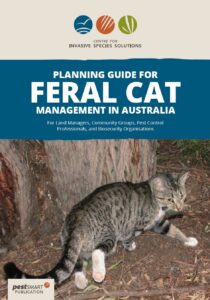
Feral cats (Felis catus) are medium-sized predators and a highly successful invasive pest species in Australia. They are also considered among the most threatening invasive species worldwide. Cats arrived in Australia as pets of European settlers and were later introduced to help control rabbits and rodents. Being highly adaptable to different environments, feral cats spread rapidly across Australia from alpine areas through deserts to the coast and to over 100 offshore islands.
Cats in Australia are all the same species (Felis catus) but can be grouped into categories based on where and how they live. What category they are assigned to can vary in different jurisdictions or organisations. In general, cats are commonly assigned to one of three groups: domestic (pet), stray and feral, although all can prey on native animals and spread disease.
This website mainly focuses on feral cats which live, hunt, and reproduce in self-sustaining wild populations in natural and agricultural habitats of all types. They have few natural predators in Australia and are not reliant on humans. Feral cats have the body shape, acute senses and fine coordination perfectly suited for stalking and capturing prey and survive exclusively by hunting and scavenging.
Feral cats impact natural environments by killing small to medium sized mammals, birds, reptiles, frogs and insects, particularly those sized between small lizards and mice to wallabies; competing with native predators like quolls for food and shelter; and spreading diseases like Toxoplasma gondii (Toxoplasmosis). Australia has the world’s worst mammal extinction rate. Since European settlement, feral cats have been primary contributors to this mammal extinction as well as two native bird extinctions and all three reptile extinctions. Examples include two species of Pig-footed Bandicoots, the Lesser Bilby, Nullarbor Dwarf Bettong, Desert Rat-kangaroo, Broad-faced Potoroo and Princess Parrot.
Feral cats impact agricultural production as vectors of diseases like Toxoplasmosis, which causes direct losses to sheep graziers in particular, but also pig, goat and poultry farmers through miscarriage and birth defects. Feral cats impose further economic costs to sheep producers by carrying and spreading the parasite Sarcosporidiosis which produce cysts in the muscle tissue, reducing the quality of the meat and causing some, or all, of the animal to be condemned at the abattoir.
All cats can impact Australia’s cultural heritage and human health by posing risks to human health through disease transmission. Recent studies estimate an annual $6 billion impact to human health and agriculture associated with cat-borne diseases, transmitted through scratches, bites, or contact with the cat’s saliva or faeces. This can range from skin and tissue infections and cat scratch fever through to Toxoplasmosis which can cause serious health problems for pregnant women particularly, including miscarriage and congenital birth defects. The cat population generally represents a high-risk reservoir for exotic diseases such as rabies and plague if an outbreak were to occur in Australia.
Since their introduction to Australia, feral cats have been hunted for meat by First Nations people and in some communities are prized as both food and recognised as good medicine. Feral cats are also recognised as a key threat to a wide range of culturally significant native animals to many First Nations people.
To learn more, you can:
- read an overview of feral cats in ‘Further Learning’
- view resources and publications about feral cats in our Resources section
- watch this Meet the Ferals episode based on three decades of Landline content. Produced and presented by reporter Prue Adams, with background information and support provided through the Centre for Invasive Species Solutions
- view a sample of our videos below and find a comprehensive selection of conference, forum, presentation and how-to videos on our YouTube channel.
6 videos found

10:05
The use of baiting for feral cat control

10:49
Protecting Kangaroo Island’s threatened species

15:02
Australian perceptions on cat management

08:57
Cage trapping for feral cats and rats

11:26

14:06
FeralCatScan allows you to map and monitor feral cats, record impacts (such as predation of native species) and document where control has been undertaken. Information you upload can help with humane, justified and effective management of feral cat populations.

FeralScan is committed to protecting users’ data, location and information, with all FeralCatScan information managed securely and discreetly as described in our privacy policy.
You can access FeralCatScan via www.feralcatscan.org.au or download the ‘FeralScan’ App and follow the feral cat prompts.
How to record:
- Register your name, or simply record data using your email address.
- Record where you have seen feral cats, predation evidence and control actions.
- Submit your record and view it on the website.
- View other sightings in your local area.
Want a quick and easy digest of management information for feral cats? Click on the thumbnail images below to download and print glovebox or management guides free of charge. Use our order form for larger quantities, which can also feature your organisation’s logo. Please note that printing and postage charges will apply to most orders.

Visit the National Feral Cat and Fox Management Coordination website for the latest research, resources, newsletters and more.






















